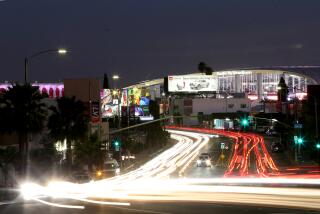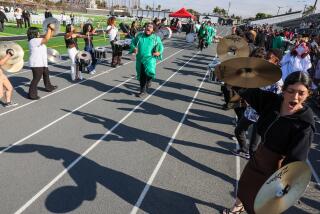UNDERSTANDING THE RIOTS - SIX MONTHS LATER : Separate Lives / DEALING WITH RACE IN L.A. : When a Neighborhood Changes : Shifting Ethnic Landscapes Evoke Fear--and Flight--in Some While Others Embrace the Newness
- Share via
Jean Brouwer lived in Inglewood when Inglewood was white, on a tree-lined street on the north side of town. She was proud of that three-bedroom house. She had thought nothing could make her leave her hometown.
“But then they started busing. And as soon as they started busing, the colored people started moving in,” Brouwer said. “I’m not saying they were bad people, but I was probably more prejudiced then than I am now, and at the time I didn’t think (busing) was right.”
Mike Triggs also remembers the day desegregation came to Inglewood schools. As a junior high student, he stood outside watching his new black classmates file off the bus.
“They wore the same kind of clothes we wore, they walked the same way we walked, we all spoke English,” Triggs said. “It wasn’t until high school that a black friend and I confided to each other that we had been scared to death.”
Brouwer and her family were scared too--so scared they abandoned Inglewood. Triggs, on the other hand, lives there today, demographics be damned.
For generations now, it has been the uncomfortable refrain in Los Angeles’ anthem of diversity: There goes the neighborhood. With every shift in the ethnic landscape comes the fear of change, the nervous many versus the adaptable few.
Although many say the difference between the two sides is racism, the reality is often more complex. Ask homeowners and they are likely to tell you that the melting pot is easier to love when it isn’t melting in your back yard.
What would you do if the faces on your block were to change and they didn’t look like yours? What if the values, the language, the music, the restaurants--the very personality of your hometown--were altered almost overnight? Would you embrace the newness or run?
This dilemma--the core of what it means to “get along” in polyglot L.A.--has played itself out during the last two decades in community after community, from the mansions of San Marino to the projects of Watts.
Inglewood 30 years ago was predominantly middle class and white. Today, it is middle class and black. Tomorrow, if demographic trends continue, it will be middle class and Latino.
Brouwer and Triggs are just two among thousands who have grappled with such change, taking different paths that have profoundly shaped their perceptions of what it means to love thy neighbor.
*
Brouwer is a 50-year-old homemaker and mother. Triggs is a 35-year-old emergency room technician. In gender and generation, they are a world apart, but they share a cultural geography.
Both grew up as part of Inglewood’s racial majority, then watched as the neighborhood’s hue began to rapidly change in the 1960s. Both learned how it feels to have racial fears and curiosities brought to the surface of their middle-class daily lives. But while one embraced the change, the other joined a wave of white flight.
“Maybe I was afraid. Maybe I held back because I didn’t know what to expect,” Brouwer said. But whatever the reason, she and her husband decided when busing began that they could no longer stay in the town where she had grown up.
“For one thing, I thought that if I could afford to live in a neighborhood, my kids should be able to go to school there,” she said. She had dreamed of seeing her children go to the same grammar school she had attended. Under busing, they had been assigned to a classroom across town.
But there were other factors--things harder to rationalize. Brouwer said she kept thinking back to when, as a teen-ager, she and her family had to cross town via surface streets.
“There were no freeways in those days, and I remembered my parents saying, ‘Be sure and lock your doors when you go through Watts,’ ” she said. “Driving through those neighborhoods left a lasting impression as to the kind of people I thought they were.”
And there were other pressures.
“My brother was an Inglewood policeman,” Brouwer said, “and he kept saying, ‘When are you getting out? How much longer are you going to wait?’ And we did want to get out before the neighborhood went down, so we could get our equity out of the house.”
So the Brouwers enrolled their sons in a Christian school, sold their dream house and moved to Norwalk in 1971, to a subdivision so new there were only three completed houses when they moved in.
It was only after the Brouwers had unpacked that they learned their quest for homogeneity had failed. The family two doors down was black.
Despite her misgivings and misplaced fear, however, Brouwer and her husband eventually got to know their new neighbors, exchanging tips on where to find the best topsoil or the cheapest source of concrete block. And as the subdivision grew, it became clear that Norwalk was becoming a destination for middle-class families of all colors.
“It just got to the point that you realize you can’t move away from it, so let’s make the best of it,” she said.
And over time, she said, she has found that being forced to interact has chipped away at her racial fears. Still, she has no close friends who are black, and her son occasionally chastens her for succumbing to prejudice.
“My son hates it when I say ‘colored people,’ ” she said. “If I don’t refer to them as African-Americans, I hear about it. But compared to some of our neighbors, I don’t think I’m prejudiced at all.”
*
Triggs came to terms with desegregation in his formative years, in the person of a classmate named Jim King. King was black, and “as I recall it, what brought us together was our mutual interest in cutting class,” Triggs said.
They cruised during class time in Triggs’ 1964 Riviera. Police pulled them over constantly.
“Once, I remember, we were all going down to Del Amo (mall). I was driving and there were three or four white kids and Jim in the car,” Triggs said. “I rolled through a stop sign or something, and we got pulled over by the police. And the only ID they asked for was his.
“I remember the cop asking him, ‘Do you have ID?’ and Jim saying, ‘All I got is my library card.’ ” After a few humiliating minutes, the officer let them go.
After graduation, Triggs left Inglewood, only to return a few years ago when a relative fell ill. To him, it didn’t matter that the majority of his neighbors were no longer white. But the woman he lives with feels it keenly.
“In Inglewood, I am definitely a minority,” said Brenda Conyers, who has lived with Triggs for two years. “I try to repress the consciousness of it a little bit. But sometimes, I’ll walk to the store and everybody working there is black, and all the customers are black, and they don’t depend on any white person for business--and I’ll feel like an outsider.”
*
Conyers, 40, was raised on the Palos Verdes Peninsula, but she also remembers when Inglewood was white. Her great-grandparents settled there, and the house in which she and Triggs live has been in her family since 1924.
Often during the 15 years she has spent off and on in the house, her address has surprised her friends. Her white boss, she said, expressed reservations about visiting. A black friend was incredulous when she confided that she often sat out on her front porch watching her portable TV.
But for as long as she can recall, the blue wooden house has tugged at her heart, and it is that house that has kept her in Inglewood.
“I still have the place mat from the restaurant where one (white) boyfriend sat across from me one night, listing all the towns where we could live together that weren’t Inglewood,” she said. Two engagements were broken over her attachment to the community before she met Triggs, whom she describes as “Inglewood to the core.”
Today, Triggs works as an emergency room technician at Daniel Freeman Hospital, a job that has taught him that grief is colorblind. The riots too were an education, Triggs and Conyers watched them from their front yard.
“We stood right here on this yard, watching them loot the market at Manchester and Eucalyptus,” Triggs said. “All the people in the neighborhood--black, white and Hispanic--all with the same concern for our safety. Any one of us could have been shot at any time. Any one of us could have died.”
Conyers spent that night at her boss’s home in Torrance, wondering whether her home would go up in flames. When she returned, it was unscathed. Only the atmosphere had changed.
“As I drove down the street,” she said, “I noticed my neighbors staring at me--the same neighbors who used to wave and say hi. They just kind of watched and stared. And when I went out for my morning jog two days later, well, it was weird. People honked at me, and it wasn’t a friendly hello. It seemed to be a warning, a get-off-the-street kind of thing.”
As if in a dream, she said, she stubbornly continued along her regular half-hour route and tried not to notice that the man waiting for her to clear the crosswalk was staring angrily. There were catcalls, she remembers. A taxi driver honked.
“I knew the significance of it. . . . I was a white person in a black neighborhood. My family and boyfriend later were angry with me. They said, ‘What did you think you were doing? This isn’t safe!’ But I felt like, this is my neighborhood too. I don’t have bars on my windows. I don’t want to come home and feel I can’t go out in my street.
“But it was an eerie feeling, and I guess I took the warning. Because I didn’t go out jogging again for about a week.”
It took about a month, she said, for that feeling to go away--a month of confusion and anger and grief and fear. But in the end, what prevailed, she said, was the stubborn goodwill of her neighborhood.
One day, without fanfare, she waved hello to the black family down the block. And, without a word, they tentatively smiled--and waved back.
More to Read
Sign up for Essential California
The most important California stories and recommendations in your inbox every morning.
You may occasionally receive promotional content from the Los Angeles Times.










